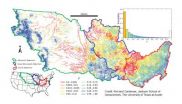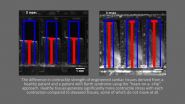(Press-News.org) Rates of cervical cancer in American women may be higher than previously thought, and the disease may arise most often at an age when adequately screened women are advised to stop getting screened. The findings come from a new study published early online in CANCER, a peer-reviewed journal of the American Cancer Society. The results should be taken into consideration when the national guidelines for cervical cancer screening are reviewed.
Removal of the uterine cervix through a hysterectomy eliminates a woman's risk of developing cervical cancer, but previous estimates of cervical cancer rates in the United States have included these women in their calculations. "In order to make accurate estimates of the true rates of cervical cancer by age in the United States and monitor trends in the occurrence of disease, it is important to calculate the occurrence of cervical cancer only among women who are at risk," explained Anne Rositch, PhD, of the University of Maryland School of Medicine, in Baltimore.
To do so, Dr. Rositch and her colleagues analyzed hysterectomy prevalence and cervical cancer incidence from 2000 to 2009. When the researchers estimated cervical cancer rates only among women with a cervix, they found that rates of disease in older women and black women were much higher than previously reported. Overall, incidence rates were 11.7 cases per 100,000 women before correcting for hysterectomies compared with 18.6 per 100,000 after correction. Also, previous reports showed that the incidence peaks at age 40 to 44 years (15.6 cases per 100,000 women) and then levels off. After correcting for hysterectomy, though, the incidence continued to increase with age, peaking at a higher rate (27.4 cases per 100,000 women) and at an older age (65 to 69 years). The effect was most pronounced among black women, given their higher prevalence of hysterectomy than white women.
The authors noted that their findings should be considered when setting national guidelines for the appropriate age to stop screening for cervical cancer. "Current guidelines recommend exiting women with recent negative screening from routine screening at age 65 years, and yet our corrected calculations show that women just past this age have the highest rate of cervical cancer," said senior author Patti Gravitt, PhD, of the Johns Hopkins Bloomberg School of Public Health. Dr. Rositch added, "It will be important to clarify in future studies whether the continued increase in cancer rates with age and the higher rates in black women represent a failure in our screening programs or a failure of the women to be screened, so that appropriate interventions can be developed to reduce the burden of cancer in these women."
INFORMATION: END
Current guidelines underestimate US cervical cancer incidence and older women's risk
2014-05-12
ELSE PRESS RELEASES FROM THIS DATE:
Fourfold increase in the rate of diagnosed cases of Celiac disease in the UK
2014-05-12
Coeliac UK, the national charity for coeliac disease announces today, 12th May 2014, new research from the University of Nottingham that has found a fourfold increase in the rate of diagnosed cases of coeliac disease in the United Kingdom over the past two decades, but, still three quarters of people with coeliac disease remain undiagnosed. ¹
The National Institute of Health & Care Excellence (NICE) previously estimated that only 10 - 15% of those with coeliac disease had been diagnosed, however, this latest research by Dr Joe West from University of Nottingham, funded ...
Research suggests human microbiome studies should include a wider diversity of populations
2014-05-12
Microbial samples taken from populations living in the U.S. and Tanzania reveal that the microbiome of the human hand is more varied than previously thought, according to new research published in the journal Microbiology. These findings suggest that the 'standard' hand microbiome varies depending on location and lifestyle.
Results compared the microbes on the hands of women in the U.S. and Tanzania and found that organisms that have commonly been identified in prior human skin microbiome studies were highly abundant on U.S. hands, while the most abundant bacterial species ...
Ice-loss moves the Earth 250 miles down
2014-05-12
At the surface, Antarctica is a motionless and frozen landscape. Yet hundreds of miles down the Earth is moving at a rapid rate, new research has shown.
The study, led by Newcastle University, UK, and published this week in Earth and Planetary Science Letters, explains for the first time why the upward motion of the Earth's crust in the Northern Antarctic Peninsula is currently taking place so quickly.
Previous studies have shown the earth is 'rebounding' due to the overlying ice sheet shrinking in response to climate change. This movement of the land was understood ...
Green-energy community projects need better government backing
2014-05-12
Community-led sustainable energy projects are not taken seriously enough by the government, according to a new report from the University of East Anglia.
Published today, the report looks at how initiatives such as community-owned solar panels, wind turbines and hydro-electricity generators, as well as energy-saving projects, could make big differences in tackling climate change.
But while a 'Big Society' ethos has formed part of the legislative programme for the coalition government, and the UK Government's new Community Energy Strategy has been a big step forward ...
Atlas shows how genes affect our metabolism
2014-05-11
In the most comprehensive exploration of the association between genetic variation and human metabolism, researchers have provided unprecedented insights into how genetic variants influence complex disease and drug response through metabolic pathways.
The team has linked 145 genetic regions with more than 400 molecules involved in human metabolism in human blood. This atlas of genetic associations with metabolism provides many new opportunities to understand the molecular pathways underlying associations with common, complex diseases.
Metabolic molecules, known as metabolites, ...
Flexible supercapacitor raises bar for volumetric energy density
2014-05-11
Scientists have taken a large step toward making a fiber-like energy storage device that can be woven into clothing and power wearable medical monitors, communications equipment or other small electronics.
The device is a supercapacitor—a cousin to the battery. This one packs an interconnected network of graphene and carbon nanotubes so tightly that it stores energy comparable to some thin-film lithium batteries—an area where batteries have traditionally held a large advantage.
The product's developers, engineers and scientists at Nanyang Technological University (NTU) ...
Hydrologists find Mississippi River network's buffering system for nitrates is overwhelmed
2014-05-11
AUSTIN, Texas – A new method of measuring the interaction of surface water and groundwater along the length of the Mississippi River network adds fresh evidence that the network's natural ability to chemically filter out nitrates is being overwhelmed.
The research by hydrogeologists at The University of Texas at Austin, which appears in the May 11 edition of the journal Nature Geoscience, shows for the first time that virtually every drop of water coursing through 311,000 miles (500,000 kilometers) of waterways in the Mississippi River network goes through a natural ...
Patient stem cells used to make 'heart disease-on-a-chip'
2014-05-11
Cambridge, MA—Harvard scientists have merged stem cell and 'organ-on-a-chip' technologies to grow, for the first time, functioning human heart tissue carrying an inherited cardiovascular disease. The research appears to be a big step forward for personalized medicine, as it is working proof that a chunk of tissue containing a patient's specific genetic disorder can be replicated in the laboratory.
The work, published in Nature Medicine, is the result of a collaborative effort bringing together scientists from the Harvard Stem Cell Institute, the Wyss Institute for Biologically ...
Ocean winds keep Antarctica cold, Australia dry
2014-05-11
VIDEO:
Dr. Nerlie Abram, from the Australian National University, explains why ocean winds have stopped Antarctica from warming as much as other continents. Her research also explains droughts in Southern Australia.
Click here for more information.
New Australian National University-led research has explained why Antarctica is not warming as much as other continents, and why southern Australia is recording more droughts.
Researchers have found rising levels of carbon dioxide ...
Hijacking bacteria's natural defences to trap and reveal pathogens
2014-05-11
The breakthrough, published in the journal Nature Materials, could offer an easier way of detecting pathogenic bacteria outside of a clinical setting and could be particularly important for the developing world, where access to more sophisticated laboratory techniques is often limited.
The research was led by Professor Cameron Alexander, Head of the Division of Drug Delivery and Tissue Engineering and EPSRC Leadership Fellow in the University's School of Pharmacy, building on work by PhD student Peter Magennis. Professor Alexander said: "Essentially, we have hijacked ...



